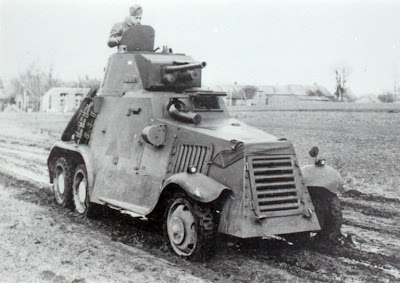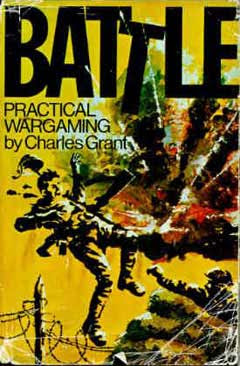Perhaps I should start by admitting that this is not the Battle of Langensalza. It is, in fact, the Battle of Seminole Ridge, as described in Charles Grant's Wargame Tactics. Of the battle reports in that book, it was Seminole Ridge which attracted me, but that battle was set in the American Civil War, and if replayed in the SYW it obviously needed a new title. 'Langensalza' was the battle in the book that actually was set in the SYW, so I swapped the names round. I hope that's all clear.
The battle is a traditional attack-defence setup, with (in my case) the Austrians defending a ridge line which covers 2 bridges. The bridges are the objective of the attacking Prussians. I went for a 6' x 6' table. The river can only be crossed at the bridges or ford.
The defenders hold the Langensalza Ridge and the ground to the south of it. The attackers deploy on their baseline along the north table edge with the objective of seizing the ridge and the bridges beyond. Mr Grant gave the attackers twice the number of units as the defenders, so I of course followed suit. Forces were:
Prussia (attacking)
Infantry brigade of 4 infantry battalions
Infantry brigade of 4 grenadier battalions
Infantry brigade of 1 Frei battalion, 2 jager battalions
Cavalry brigade of 2 cuirassier regiments
Cavalry brigade of 2 dragoon regiments and 1 hussar regiment
Artillery park of 3 medium batteries, 1 light battery and 1
howitzer battery
21 units.
Austria
(defending)
Infantry brigade of 3 infantry battalions
Infantry brigade of 1 infantry battalion and 2 grenz
battalions
Cavalry brigade of 1 cuirassier regiment and 1 dragoon
regiment
Artillery park of 2 medium batteries and 1 light battery.
3 feet of entrenchments
11 units.
To give some interest to the deployment process, I decided on the old school process of a curtain across the table, removed once deployment was complete. The details of how I contrive this are in an
earlier post. We allocated sides by dice roll - I got the Austrians, my opponent Steve the Prussians. I'll take the liberty of describing the game from my perspective.
The Game.
Despite its rather Heath Robinson nature, the curtain went up easily enough, accompanied by comments about 'hanging out the washing on the Seigfried Line' from my opponent. There were further comments as we both set out our forces. I admit I do have a habit of muttering to myself when concentrating, but Steve's offer to call Social Services was typical of the sometimes hurtful badinage by which he seeks to gain a psychological advantage during our games. The swine. On removing the curtain, the two sides had deployed as per the photo below.
 |
| A little frightening to see one's opponent's baseline stuffed with so many troops. The important thing to note is that all the Prussian cavalry was on their right flank, the other flank being held by light troops. My own small cavalry brigade would have its work cut out. |
 |
| And so it transpired. The Prussian cuirassiers forged ahead of their comrades, who were impeded by a wood, and charged into the thin but valiant line of Austrian horse. My own cuirassiers scored first blood and the leading Prussian unit was quickly done for. |
 |
| Here we see the advance of the Prussian grenadiers. The Prussian line infantry (being moved in the background) proved reluctant to advance beyond Langensalza for a number of moves, with a hesitancy which (in my opinion) bordered on cowardice. |
 |
| The cavalry melee intensifies as the dragoons of both sides clash. There really was only one possible outcome, but I felt I had little choice but to fight it out and hope for the best. |
 |
| Overview around mid game. In the distance you can see that my cavalry have been overcome and the Prussian dragoons are preparing to attack the flank of my infantry line. In the foreground, Prussian light troops and the grenadiers make steady but unspectacular progress. The line infantry brigade is stuck at Langensalza, whilst the Prussian artillery on the Langenburg fires at the Austrian entrenchments, with surprisingly little effect so far. |
 |
| Again my forces are overfaced, this time on the right flank. Two grenz units do their best to hold off Prussian jager and grenadiers. Once more, the eventual result was not in doubt but the Austrian light troops had the pleasure of seeing the Prussian Garde Grenadier battalion leave the line and hasten to the rear, as a result of their steady fire. |
 |
| Another overview around the same time. The noose is tightening around my troops, on both flanks. |
 |
| And so to the awful denouement. Here you can see that the leading Prussian dragoon regiment has driven one Austrian infantry battalion from their entrenchments, then continued on to charge the supporting artillery unit. The gutsy gunners saw them off but there was plenty more Prussian cavalry to come... |
 |
| ... as you see here. The Prussian cavalry threw a double move, and now charged the guns in flank, as well as charging 'Loudon's Grenadiers' who were attempting to come across the table to prop up the crumbling Austrian flank. The Prussian hussars exploited the work of their comrades by galloping over and capturing the western bridge. No prizes for guessing that my artillery battery was destroyed, along with Loudon's battalion, which had been caught in march column. |
 |
| Prussian artillery fire had also now dislodged the Austrian units manning the eastern end of the entrenchments, and the attacking grenadiers are seen here cresting the rise to the astonishment of a lone Austrian staff officer. The Austrian artillery battery at this end of the ridge struggles to extricate its guns. |
 |
| Oh, please make it stop! The second unit of Prussian cuirassiers, having hacked down my artillery unit, moved on to charge the last remaining infantry unit on this part of the ridge in flank. Already softened up by a blast of canister, the white clad men were quickly done for. The Austrian light gun in the foreground predictably did little to bother the Prussian hussars crossing the bridge. |
 |
| And that was about it. Only the light troops on the Austrian right flank still held their original positions. This overview shows the situation around about move seven, though by this time I had given up counting moves as unit after unit headed off the table for their storage boxes. Oh, the shame! |
 |
| The Prussian line brigade is seen here finally leaving the outskirts of Langensalza as the game ended. They hadn't been needed in the end, but their threat had helped to pin my own infantry in their entrenchments. |
 |
| Another Austrian staff officer has an unexpected encounter with advancing enemy troops. The bridge is a new one acquired at 'Colours' in September. |
Conclusion.
I had been resoundingly thrashed, losing 7 of my 11 units, as well as one of the bridges and the whole of the ridge. Steve had lost only 2 of his 21 units. My tactics were certainly not the best. It was obvious from the start that my cavalry would be overwhelmed, and I should have redeployed some units to cover my left flank in anticipation of this. Both sides had their share of bad luck, so I certainly couldn't blame the dice rolls either.
There is the question of how evenly balanced the scenario was, but Mr Grant rarely gets these things wrong. The battle when played out in his book was a near run thing. I think I would add another infantry unit to the Austrian force in future, though.
The rules used were my own. Gaming time was about 2.5 hours. And yes, I did enjoy myself, despite a crushing defeat. That's wargaming, after all.











































